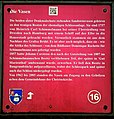Wandsbeker Castle



The Wandsbeker Castle was a late Baroque mansion in the Holstein town of Wandsbek , which is now part of Hamburg as a district . It was the end of the 18th century on the remains of the older Wandesburg built and canceled. 1861
history
In 1564 Heinrich Rantzau acquired the Wandsbek estate and had a three-wing moated castle built in place of the existing manor house, which probably dates from around 1520, and called it the Wandesburg . In addition to Wandsbek, Rantzau also owned the Rantzau Castle and the Breitenburg Castle . Rantzau belonged to the so-called humanists and cultivated extensive contacts. One of his guests at the Wandesburg was the astronomer Tycho Brahe , who worked and researched here for eleven months from October 1597 to September 1598 and for whom the castle tower was converted into an observatory .
In 1641 Wandsbeck Castle came into the possession of Count Christian von Pentz , governor in the Danish service of Glückstadt and son-in-law of Christian IV of Denmark. In 1645, however, it passed to the Hamburg merchant Balthasar Behrens, who fundamentally rebuilt it from 1645 to 1648.
In 1679 Friedrich Christian Kielman von Kielmansegg acquired the castle. In 1705 he sold it to his son-in-law Joachim von Ahlefeldt (1670–1744), who severely neglected the property and had to file for bankruptcy in 1740.
In 1762 the property went to the Danish Finance Minister Heinrich Carl von Schimmelmann , who had previously acquired the Ahrensburg Castle as a summer residence. Schimmelmann had the old manor house demolished and the Wandsbeker Castle built on the foundations by Carl Gottlob Horn and surrounded by an extensive garden at the transition from a baroque park to a landscape garden. The castle was one of the most famous facilities of its time in the region and became a center of culture and society thanks to the Schimmelmanns.
The descendants of Schimmelmann got into financial difficulties during the 19th century. In 1857 they sold the Wandsbeker property for 230,000 Reichstaler to Johann Anton Wilhelm von Carstenn . The land was parceled out and sold by the new owner, and the castle was demolished in 1861. City villas and residential houses were built on the former castle grounds, creating what is now Hamburg's Marienthal district . Part of the former palace garden has been preserved as a public green area at Wandsbeker Gehölz .
The castle grounds today
Today there are no more visible traces of the Wandesburg and Schimmelmann Castle. Only the street names Schloßstraße , Schloßgarten and the neighboring Rantzaustraße remind of the former location of the castle .
Some architectural fragments have also been preserved: The attic of the palace was set up in the Eichtalpark until 1980 , today it is kept in a side entrance of the Wandsbek district office. Two lion sculptures and two decorative vases from the former palace park now line the Wandsbeck market square . An underground construction remnant of the old walled castle was added to the list of ground monuments in 2009 .
literature
- Tatjana Ceynowa: The Wandsbeker mansion of Heinrich Rantzau. On the history of a noble estate in Holstein . Ludwig, Kiel 2004, ISBN 3-933598-88-5 ( Kieler Kunsthistorische Studien . Volume 7) ( partly online ).
- J. Frank, M. Pommerening: The Wandsbeker Castle. Rantzau, Brahe and the Schimmelmann family. Muehlenbek Verlag, 2004 ( publisher's advertisement )
- Joachim W. Frank: The Wandsbeker Schlosspark and its equipment , in: The order of nature , lectures on historical gardens and parks in Schleswig-Holstein, in: Publications of the Schleswig-Holstein State Archives , Volume 96, 2009, p. 37ff. Digitized
Web links
- Reconstruction drawing by Wolfgang Braun
- Representation on the Rantzau board (third from above)
Individual evidence
- ↑ Tatjana Ceynowa: The Wandsbeker manor house of Heinrich Rantzau: on the history of a noble estate in Holstein ; P. 228
- ↑ List of monuments of the Free and Hanseatic City of Hamburg, as of April 13, 2010 (PDF; 915 kB) ( Memento from June 27, 2011 in the Internet Archive )
Coordinates: 53 ° 34 ′ 14 " N , 10 ° 4 ′ 10.2" E





